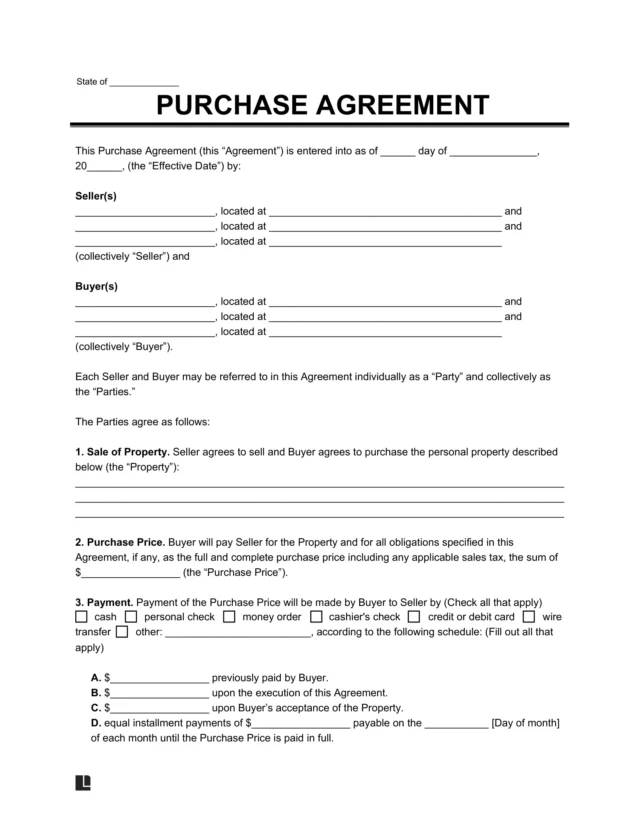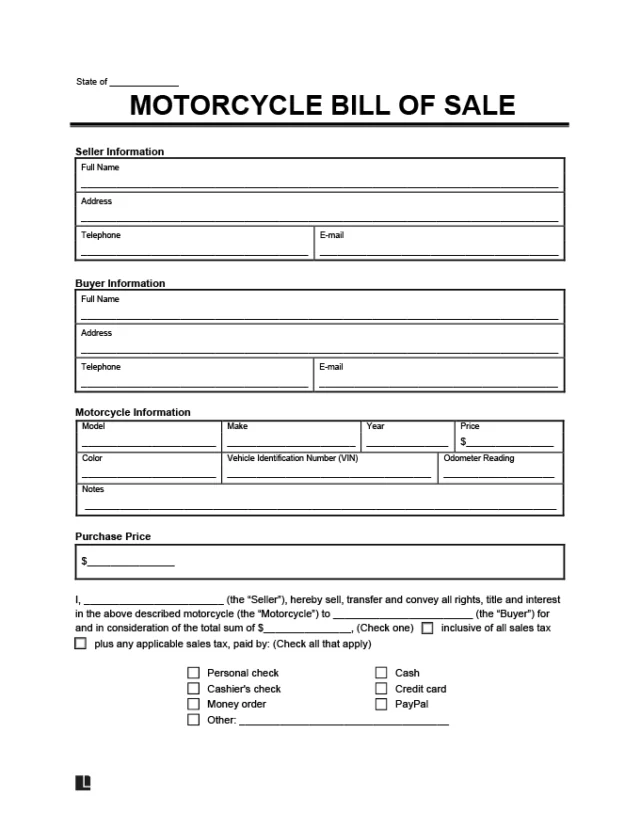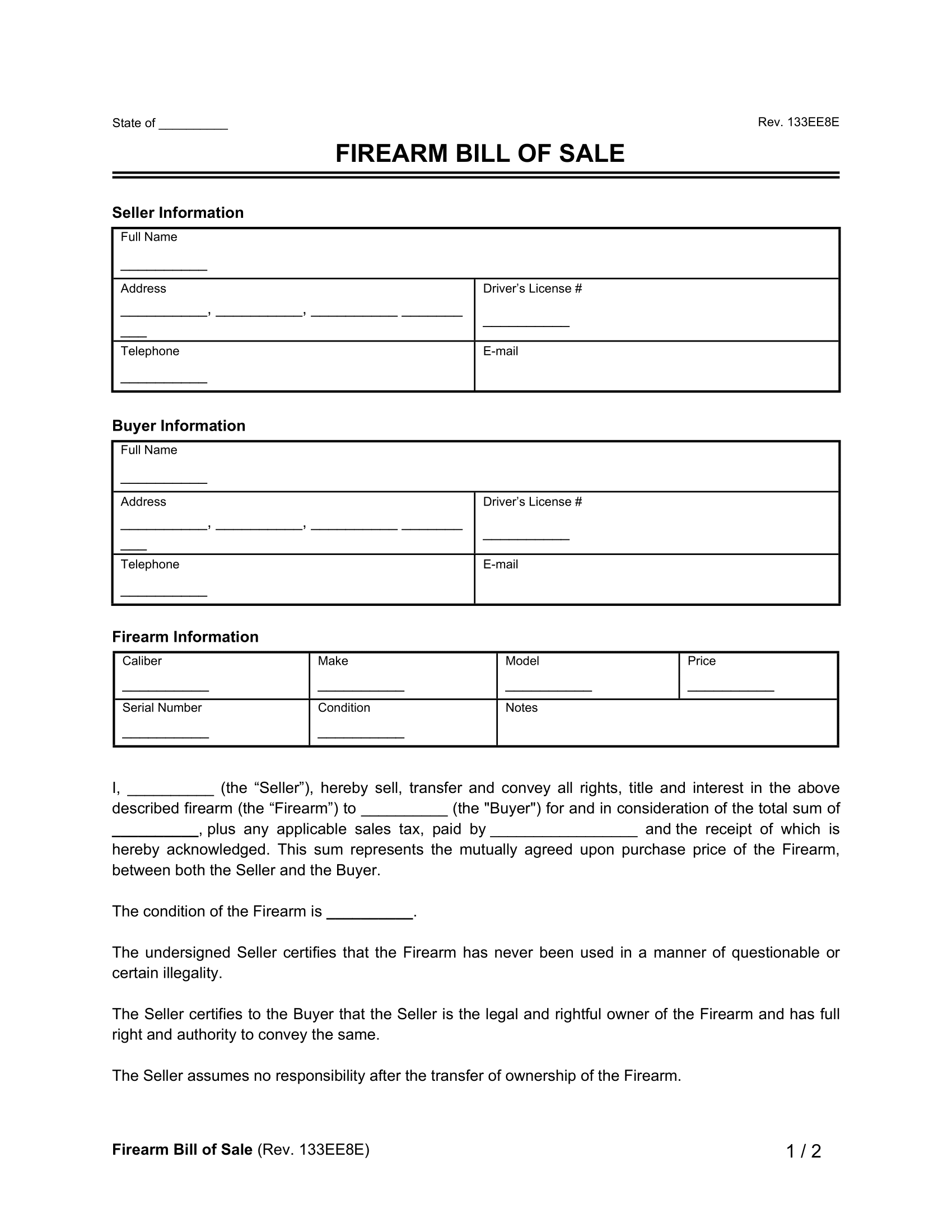What Is a Firearm Bill of Sale?
A firearm bill of sale records the legal transfer of a gun from one person to another. It includes the buyer and seller’s names, the gun’s make, model, serial number, sale date, and price.
This document helps protect both parties. If the gun is later lost, stolen, or linked to a crime, it shows who sold the firearm, who bought it, and when. That’s especially important in private sales, where there’s no federal record of the transaction.
A bill of sale for a gun is not the same as a Firearms Transaction Record, also known as Form 4473, which is used by Federal Firearms License (FFL) holders. While simpler, it still provides important legal documentation for private transfers.
Firearm Bill of Sale – By State
Follow your state’s guide to draft a gun bill of sale that meets local laws.
- Alabama
- Alaska
- Arizona
- Arkansas
- California
- Colorado
- Connecticut
- Delaware
- District of Columbia
- Florida
- Georgia
- Hawaii
- Idaho
- Illinois
- Indiana
- Iowa
- Kansas
- Kentucky
- Louisiana
- Maine
- Maryland
- Massachusetts
- Michigan
- Minnesota
- Mississippi
- Missouri
- Montana
- Nebraska
- Nevada
- New Hampshire
- New Jersey
- New Mexico
- New York
- North Carolina
- North Dakota
- Ohio
- Oklahoma
- Oregon
- Pennsylvania
- Rhode Island
- South Carolina
- South Dakota
- Tennessee
- Texas
- Utah
- Vermont
- Virginia
- Washington
- West Virginia
- Wisconsin
- Wyoming
When to Use a Firearm Bill of Sale
Private gun sales are the most common use of a firearm bill of sale. Federal law doesn’t require it, and neither do most states, but it’s still a smart step. It gives both parties a clear record of the deal.
That record matters even more in states with extra rules, like background checks or added paperwork. A bill of sale keeps the transaction documented and easy to verify.
The federal Bureau of Alcohol, Tobacco, Firearms, and Explosives, also known as ATF, recommends using one for any private firearm sale. It confirms the gun was legally transferred and includes the basics:
- Buyer and seller names
- Firearm details (make, model, serial number)
- Date and sale terms
If questions come up later, the bill of sale can help prove the transaction was legitimate.
How to Write a Firearm Bill of Sale
A firearm bill of sale adds an extra layer of protection to your transaction. Follow these tips to make sure the sale is properly documented and secure.
1. Check State and Federal Laws
Before selling a gun privately, take some time to familiarize yourself with both state and federal laws. What’s allowed in one place may be restricted in another, and the finer points can be easy to miss.
Some states allow gun sales with minimal restrictions, while others have tighter controls. Here are some examples of rules to keep in mind; however, keep in mind that this list is not exhaustive.
Seller responsibilities:
- Find out if private sales are allowed where you live.
- Some states require all private sales to go through a licensed dealer (including California and Washington, for example).
- If the buyer lives in a different state, the sale typically needs to go through a licensed dealer.
- Under the Gun Control Act (GCA), if you repeatedly buy and resell firearms with the intent to profit, you may need a Federal Firearms License (FFL).
- State laws also have their own rules, like Connecticut’s requirement for a state retail sales permit if you sell ten or more firearms in a year.
Buyer responsibilities:
- Register the firearm after buying it if your state requires it (for instance, Hawaii and DC both require this).
- Get any permits or licenses you need to own or carry the gun.
- Pass any background checks required for private sales (like in Illinois, Massachusetts, and New York, for example).
Both parties’ responsibilities:
- Follow all laws about banned or restricted guns, federal and state.
It’s important to do your own research before buying or selling a firearm. Always check the laws in both the buyer’s and seller’s location before completing a gun bill of sale. It’s the safest way to stay compliant.
| State | Background Check Required | Required Registration | Required Permit to Purchase | Required License to Own | Required Permit to Carry a Concealed Handgun | Laws |
|---|---|---|---|---|---|---|
| Alabama | No |
No | No |
No | No | Ala. Code § 13A-11-60 et seq. (2024) |
| Alaska | No |
No | No |
No | No | §§ 11.61.190 to 11.61.220 |
| Arizona | No |
No | No |
No | No | ARS. Title 13: Chapter 4, 31 |
| Arkansas | No |
No | No | No | No | §§ 5-73-101 to 5-73-313, §§ 5-73-301 to 5-73-327 |
| California | Yes |
Yes | No | No | Yes | Penal Code Parts 1-6 |
2. Use a Template
You can write a firearm bill of sale by hand, but using a template is a better option. It helps you include all the right details and keeps the document well-organized and easy to read.
Legal Templates’ free form takes care of this for you. With everything clearly laid out, it’s easy to store and use later.
3. Enter Seller Information
Start by entering the seller’s information. This section helps identify who transferred the firearm and makes the record easier to verify. Include:
- Full name, street address, city, state, and ZIP code
- Driver’s license number for ID confirmation
- Phone number (and email, if available) for contact purposes
Complete contact details make the gun bill of sale more reliable and easier to reference. For example, if the firearm is recovered during an investigation, police may need to trace its history to identify the previous owner.
4. Enter Buyer Information
Once the seller’s details are recorded, move on to the buyer’s information. These fields mirror the seller’s section to keep the record consistent and complete. Include:
- Full name, address, city, state, and ZIP code
- Driver’s license or state ID number to confirm identity
Adding this information also helps protect both parties and keeps the bill of sale clear if you need to refer back to it.
5. Fill in Firearm Details
Next, fill in the firearm details. These help identify the exact gun being sold and make the record clear. Include:
- Caliber, make, model, and serial number
- Condition of the firearm, chosen from a list (such as new, good, fair, or poor)
- Optional notes or description, like accessories, modifications, or visible wear
Providing precise details like the serial number and condition ties the sale to one specific firearm. This prevents fraud by stopping anyone from swapping or misrepresenting the gun later, protecting both buyer and seller from false claims.
6. Add Price and Payment Info
Being specific about the amount and method of payment in a firearms bill of sale helps prevent misunderstandings. It leaves no room for misunderstanding about what was paid and how. Include:
- Total sale price agreed upon
- Note if sales tax is included or not
- Payment method, such as cash, check, money order, or electronic transfer
This creates a clear record that shows both parties agreed on the terms. It can help if the firearm is later reviewed during a background check, tax filing, or legal process.
7. Record Date of Sale
Record the exact date the sale takes place. This marks when the firearm legally changes hands and helps establish a clear timeline.
Using the correct date is important for legal and recordkeeping purposes. If the transfer is ever questioned, the bill of sale will show when ownership officially changed.
8. Choose Notary Option
No US state currently requires notarization for a firearm bill of sale. But it can still be a smart precaution to take. A notary confirms the identities of the buyer and seller, which may help prevent fraud or misunderstandings.
If the sale is questioned or ends up in a legal dispute, a notarized bill of sale provides stronger proof that the transfer was legitimate.
Sample Firearm (Gun) Bill of Sale Template
Below is a sample to show you what a finished form looks like. When you’re ready to create your own, you can download the firearm bill of sale template in Word or PDF.









